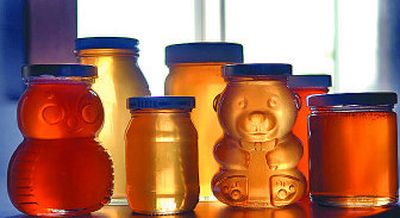The hives have it

“This is a hobby that once you get started, it’s hard to give up,” said Jim Miller, confessing his passion for beekeeping.
President of the Inland Empire Beekeeping Association, Miller has been a hobbyist beekeeper since 1995.
In 1994 Miller and his wife Jenine had hopes of a mini Greenbluff on their new property, Millers Homestead, outside Cheney. In the spring they planted 200 fruit trees and bought two beehives. The trees did well over the summer, but that winter there was a heavy snow. Miller didn’t think to check on the trees until spring. When he did, mice had destroyed all 200.
“So we lost the trees and the bees stayed,” said Jim.
Now they have 15 hives and three kinds of honeybees, with a fourth on the way. Each type of bee has a different temperament, which they found out the hard way when they ordered Russian bees.
“Russian bees are very aggressive,” said Miller. “When we opened the package, they had an attitude. They were taking us on – getting in our hair, stinging us. I had to move them to a different lot in downtown Cheney.”
In 2005 Miller went to the former Soviet republic of Georgia to teach beekeeping at the request of the USDA. There he met Caucasian bees, a mild type that he enjoyed working with and now has on order.
“They’ll work in a cooler climate,” said Jim. “They were gentle – I was standing right near their hives without any gear on, and they didn’t bother us. You don’t do that here, with our bees. You need to suit up.”
The Millers have a separate building almost entirely devoted to beekeeping. With two extractors, Miller helps other beekeepers draw honey from their frames. First the frames are put into a hot room up to 85 degrees so the honey will flow. Then they are put into an extractor, where they spin until all the honey drains out. The honey then goes through three sets of filters to remove all the bee parts and wax.
Jenine uses the beeswax to make lip and hand balm. The Millers make four different kinds of honey: wildflower, buckwheat, crystallized and creamed. The flowers the bees frequent create the taste and color of the honey. The temperature decides the clarity. And if you turn a bottle of honey upside-down, the speed of the air bubble determines the quality.
“See the bubble?” said Miller, holding up one of his bottles. “Notice how slow it’s moving? If you go into a grocery store and do that, you’ll see it moves a lot faster. USDA said we could have up to 24 percent water in our honey. When it comes out of the hive it’s between 13 and 18 percent. We don’t add water to our honey. If the bubble is slow moving, then it’s good honey.”
Beekeepers must pay close attention to their hives to prevent disease. Mites are a common problem. The Varroa mites have sticky pads on their feet and crawl on the bees’ backs, sucking their blood. Miller puts powdered sugar on them to loosen their grip. Tracheal mites enter the bees’ lungs, causing suffocation. Miller uses peppermint oil to drive them away.
One of the scariest bee diseases is colony collapse disorder. Recently destroying colonies across the country, there is no known cause or cure for this disease. Miller believes it stems from pesticides and herbicides. The bees bring these chemicals into the hive and they get into the wax, masking the smell of the queen. Once the bees can’t sense the queen, they leave the hive.
“They go by odors,” said Miller. “They know it’s their hive and where it’s located.”
Bees’ behavior is dictated not only by pheromones but also by body motions. They do certain dances within the hives to explain to other bees the locations of the best flowers. The time of year and food supply also affect their temperament, something important to keep in mind to prevent bee stings.
The worker bees, the females, can sting only once, as their innards are removed with the stinger. The drones, the males, don’t have stingers, so they’re safe to touch.
“If there’s a good nectar flow going, and good pollen, they’re somewhat passive, like a drunken sailor,” said Jim. “But when the food starts to dwindle, they get aggressive. Toward September, you’re on your own.”